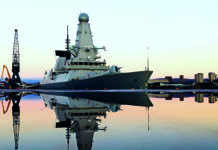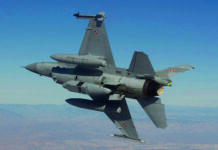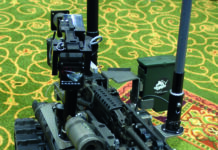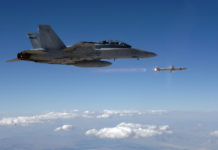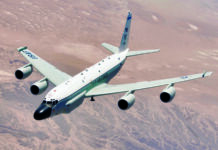Comprehensive Electronic-Warfare (EW) suites have long been a feature of most surface warships, but the brief survey that follows will focus on the equipment fitted to the latest ships from a selection of the world’s major navies. Although some modern warships are being fitted with sensors able to detect incoming laser energy, and in some instances with anti-laser countermeasures, the text will focus on Radio-Frequency (RF) hardware.
US Defences
The primary electronic warfare system on US Navy ships is the Raytheon AN/SLQ-32. First fielded in the late 1970s, and probably the most widely-deployed naval EW system, this has seen service in seven basic variants. Early versions were passive and had no jamming capability. The (V)1 was designed to receive high-band radar signals typically transmitted by aircraft and missiles and was fitted to auxiliary ships and frigates, while the (V)2 installed on some frigates and on destroyers could also detect enemy surveillance and targeting radars.
SLQ-32(V)3 was the first variant to add an active radar-jamming capability, and was installed on cruisers, battleships, large amphibious ships, and high-value replenishment vessels. Aircraft carriers were fitted with the SLQ-32(V)4, which consisted of two (V)3 systems (one on each side of the ship), and a common computer and display console. The EXOCET attack on the OLIVER HAZARD PERRY class frigate STARK in 1987 triggered the development of the SLQ-32(V)5, a more compact version of the (V)3 system that provides this class of warship with an active-jamming capability.
Since the SLQ-32 had been designed in modular form, upgrades were easy to implement and were often conducted when a ship underwent major overhaul. So (V)1 systems were often modified to the (V)2 standard, and (V)2 versions could become (V)3.
SLQ-32 was to have been replaced by the AN/SLY-2 Advanced Integrated Electronic Warfare System (AIEWS), but this programme was cancelled in 2002 due to over-runs in time and cost. It was replaced by the Surface Electronic Warfare Improvement Programme (SEWIP), which uses an open architecture in order to allow rapid integration of emerging technologies.
SEWIP Blocks
Block I (which is sub-divided into Blocks 1A, 1B1, 1B2, and 1B3) is intended to improve anti-ship missile defence, counter-targeting and counter-surveillance capabilities, as well as tackling hardware-obsolescence issues. It also adds Specific Emitter ID (SEI) and High Gain/High Sensitivity (HGHS) capabilities intended to provide improved situational awareness. HGHS is intended to provide better capability against low-probability-of-intercept signals.
SEWIP Block 2 includes an upgraded antenna, a new digital receiver and enhanced processing capabilities. The combination of Block 1B3 and Block 2 hardware creates the SLQ-32(V)6 standard, which entered service in 2014 on the DDG 51 Flight IIA destroyer BAINBRIDGE (DDG 96). It is now in service on a growing number of DDG-51 guided-missile destroyers, also on DDG-1000 destroyers and on large-deck amphibious ships. The planned CONSTELLATION class frigates will have two SLQ-32(V)6 Surface Electronic Warfare Improvement Programme (SEWIP) Block 2 systems.
A compact SLQ-32(V)6C variant – also known as SEWIP Lite – was developed for use on the Littoral Combat Ship (LCS), but its first application was the US Coast Guard’s Offshore Patrol CUTTER.
SEWIP Block 3 provides improved Electronic Attack (EA) capability intended to keep pace with the evolving threat. A combination of the Block 1b, Block 2, and Block 3 will make up the SLQ-32(V)7 standard, which is earmarked for use on DDG-51 destroyers, NIMITZ and FORD class aircraft carriers, and WASP class amphibious assault ships.
NATO Solutions
No other navy can match the sheer scale of the SLQ-32/SEWIP programme, but many are trying to standardise the EW suites deployed aboard shrinking numbers of ships. The UK Royal Navy’s Type 45 DARING class destroyers are equipped with the Thales VIGILE-D wideband digital Electronic Support Measure (ESM) system as part of the UAT Mod 2.0 and 2.1 programmes. There is a follow-on UAT Mod 2.3 programme, and VIGILE-D will be introduced to the rest of the UK’s surface fleet. It has also been ordered by several other navies in NATO and the Middle East. The Type 45 is also equipped with the SHAMAN communications electronic support measures (CESM) system, a variant of the AN/SSQ-130(V) increment F which entered USN service in 2016.
France’s FORBIN class (HORIZON) destroyers are fitted with a SIGEN consortium (Thales/Electronica) EW suite comprising radar warning equipment, a high-power jammer, and an ESM/ECM support aid, while a Thales ALTESSE-X provides comint (CESM). Two EADS NGDS 12-barrelled multifunction decoy launchers are also carried. SIGEN also provides the EW suite for the AQUITAINE class destroyers, which are also fitted with two EADS NGDS decoy launchers.
The EW installation for the French Navy’s planned class of five Defense and Intervention Frigate (FDI) warships has not yet been fully defined. AMIRAL RONARC’H – the first of the new class – is due to be delivered by the end of 2023, and the final example by the end of the decade. Potential components for the EW suite include the Thales’ SENTINEL ESM and EW system and ALTESSE-H comint system, plus unspecified launchers for chaff, flares, and corner-reflector decoys.
Italy’s ANDREA DORIA class destroyers are reported to be fitted with a MM/SLQ-750 system with electronic support measures (ESM) and electronic countermeasures (ECM) capability, plus two Otobreda SCLAR-H 20-barrel trainable chaff/IR flare launchers, while the BERGAMINI class multimission frigates combine the MM/SMQ-765 with the Thales ALTESSE-X, the Elettronica NETTUNO 4100 modular H-J band jamming system, and two countermeasures launchers. On the first six ships, these will be Leonardo SCLAR-H, but the OTO Launching Decoy System 20 (OLDS 20) has been selected for the remaining four.
Russian Systems
ADMIRAL GORSHKOV, the lead ship of the new class of guided missile frigates for the Russian Navy, was laid down in February 2006. However, construction and fitting out were protracted, and the vessel was not launched until 2010. It did not enter service until July 2018. Two are now in service, and a third is due to be commissioned by the end of 2021.
These are equipped with the KRET TK-28E/5P-28 ESM system, the PROSVET-M countermeasures launcher, and a CT-308 launcher able to release corner reflectors. The performance of the TK-28E/5P-28 is thought to be similar to that of the TK-25E, a version intended for smaller ships such as offshore patrol vessels. The latter system can detect emissions between 500 MHz and 40 GHz, analysing up to 100 signals simultaneously, and is able to jam two threats simultaneously. In 2020, Russia’s TASS news agency reported that the two GORSHKOV class ships currently in service would be retrofitted with upgraded radars and modernised EW systems, but gave no details.
Delays with production of GORSHKOV class led to the decision to build the ADMIRAL GRIGOROVICH class frigates. Their EW suite is reported to include the TK-25-5 ESM system and four KT-216 decoy launchers. A total of six frigates are planned, but only three are in service. Two of those currently fitting out have been assigned to the Indian Navy, and the third may share their fate.
Conceived as a cheap alternative to the ADMIRAL GRIGOROVICH class frigates, Russia’s Project 22800 (KARAKURT class) missile corvette was announced in 2015. The first-of-class was launched in July 2017, and accepted into service in December 2018. Rosoboronexport is promoting the new class, but has released no information on its EW systems. Antennas for these are presumably contained in the ship’s integrated mast.
Information regarding the EW fit of Chinese warships is somewhat sketchy. LUYANG I (Type 0528) destroyers team a SRW 210A ESM system designed for use aboard large and medium-sized warships with TYPE 984 AND TYPE 985 jammers covering I-band and E/F band respectively, and four 18-tube launchers for 100 mm decoys, but the follow-on LUYANG II (Type 052c) and LUYANG III (Type 052d) destroyers are fitted with the NRJ-6A, one of a family of modular systems offering threat-warning and jamming. JIANGWEI II-class (Type 053H3) frigates use the SR-210 ESM system, TYPE 981-3 noise jammer, and RWD-8 deception jammer, plus two chaff launchers.
Launchers
Whether used to deploy chaff or other types of decoy, launch systems continue to play a major role. On USN ships, the SLQ-32 can be used to control the BAE Systems Mk 36 SRBOC Chaff and Decoy Launching System. This is a deck-mounted, 6-barreled mortar system able to launch chaff and infrared countermeasures intended to lure hostile missiles away from ships under attack. The number and arrangement of these launchers depends on the size of the ship, and can range from two launchers on a small combatant to as many as ten on an aircraft carrier. More than 1,000 systems are in service with the USN and with at least 19 other navies worldwide.
In April 2021, Rheinmetall announced the delivery of the 300th Multi Ammunition Softkill System (MASS). The customer was the Finnish Navy, which was also the system’s first customer. Close to two decades after product launch, MASS is now in service with 14 navies. A typical installation consists of between one and six trainable launchers.
The most recent variants are the MASS OCR with off-board corner reflector and a the new MASS ISS standalone version with an integrated sensor suite for use on ships that lack an independent capability for detecting laser and radar threats. MASS OCR uses launchers armed with two off-board corner-reflector rockets that produce ship-like radar signatures at locations between 35 and 850 m of the ship, and maintain their decoy effectiveness for more than 60 seconds. MASS ISS includes the REKa-50 subsystem able to detect threats operating in the millimetre-wave frequency range.
Lacroix’ New Generation Dagaie System (NGDS) is a two-axis trainable DLS system used by the French Navy and in what the company describes as “in a major foreign navy”. In late 2020 Lacroix and Leonardo agreed to integrate Leonardo’s MJTE (Mobile Jammer Target Emulator) into the SYLENA Mk2 launcher for small and medium-sized ships in order to protect these against subsurface threats.
Future Developments
It is questionable whether chaff and IR decoys will be able to counter the most sophisticated radar seekers fitted to some modern antiship missiles, so several companies have developed or are developing self-propelled decoys able to move away from the ship that has released them, and maintain whatever position or trajectory might be needed to maximise their effectiveness.
Developed by Australia and the US, the NULKA decoy is powered by a solid-propellant rocket. It is designed to hover and to move away from the ship that launched it, maintaining a pre-programmed height and speed. Its payload is a broad-band RF repeater able to radiate a large radar-cross-section signal while the NULKA flying a trajectory that mimics the likely behaviour of a warship, thus presenting an attractive target to incoming missiles.
In 2015, the carrier USS DWIGHT D EISENHOWER successfully completed launch trials for the NULKA. Over a three-day period, the carrier used its MK 53 decoy launching system (DLS) to launch the NULKA decoy five times.
NULKA had its combat debut on 9 October 2016, when the guided-missile destroyer USS MASON and two other US warships were faced with two antiship missiles fired from the Yemeni coast by Houthi rebels. Mason fired two Standard Missile-2 (SM-2) and one Evolved SEASPARROW Missile (ESSM) against these threats, but also launched a NULKA. The US Navy’s planned CONSTELLATION class frigates will have four Mk NULKA decoy launching systems.
A custom-designed NULKA munition adapter allows the munition to be quickly and cost-effectively inserted into an Extensible Launching System (ExLS) designed to fit inside a cell of the MK 41 or MK 57 Vertical launch System (VLS), but Lockheed Martin had developed an ExLS standalone variant suitable for use on surface ships that are not equipped with a VLS. Developed in only 10 months, it was tested at the Royal Australian Air Force’s Woomera Test Range in South Australia, were it successfully launched two NULKA decoys.
Thinking for the Long Term
In 2019, the US Office of Naval Research awarded concept-design contracts to BAE Systems and Raytheon under the Long Endurance Advanced Offboard Electronic Warfare (AOEW) Platform programme covering initial work on a proposed long-endurance softkill countermeasure against anti-ship missiles. Goal of this programme is to develop an expendable flight vehicle and an active-decoy payload that could enter service before the end of the decade. The payload is expected to weigh less than 10 kg, and be able to maintain two-way communications with the vessel it is protecting.
In 2020, Lacroix announced its Véhicule Ejecté Support Tactique d’Autoprotection (VESTA), a rotary-wing Uninhabited Air Vehicle (UAV) to be launched from a ship’s countermeasures dispenser by a rocket booster. Likely to be of six-rotor configuration, this will loiter at a distance from the ship, and transmit a jamming waveform. VESTA is a long-term project and is not expected to deliver operational hardware until around 2030.
A different approach to creating a long-duration offboard decoy is illustrated by the Royal Canadian NAVY’S Naval Off-Board Anti-Missile Active Decoy (NOMAD) programme. This is based on a Meggitt HAMMERHEAD Unmanned Surface Vehicle carrying a jamming payload developed by Elbit Systems. Normally used as a target, HAMMERHEAD has an endurance of around 24 hours when travelling at speeds of 20 knots. Tests intended to validate the NOMAD concept are due to begin this year.
In mid-2019, the UK Ministry of Defence issued a Request for Information on EW technologies that could meet future Royal Navy requirements for softkill anti-missile defence. It expressed interest in off-the-shelf trainable decoy launchers, and expendable carriers or recoverable UAVs able to carry EW payloads.




